BSc Healthcare Studies: Anesthetic Impact on Pediatric Agitation
VerifiedAdded on 2023/06/15
|8
|2268
|241
Literature Review
AI Summary
This literature review investigates whether the use of intravenous anesthetics (TIVA) reduces the risk of emergency agitation (EA) compared to inhaled anesthetics (IA) in pediatric patients. Emergency agitation, characterized by behavioral discomfort and potential harm, is common in children recovering from general anesthesia. The review analyzes existing literature, focusing on studies comparing TIVA and IA techniques, with a particular emphasis on sevoflurane and propofol. The methodology involves a comprehensive search of electronic databases like CINAHL and Cochrane Library, using Boolean operators to refine the search. The review critically appraises the retrieved literature using CASP tools to assess relevance, trustworthiness, and reliability. Ethical considerations are addressed by acknowledging all sources and avoiding plagiarism, as the review does not involve direct human subject research. The project milestones include literature search, article selection, reading, structural planning, and report writing, culminating in submission and dissemination of results. The primary aim is to determine which anesthetic procedure is more effective in reducing the likelihood of emergency agitation among children undergoing surgery.
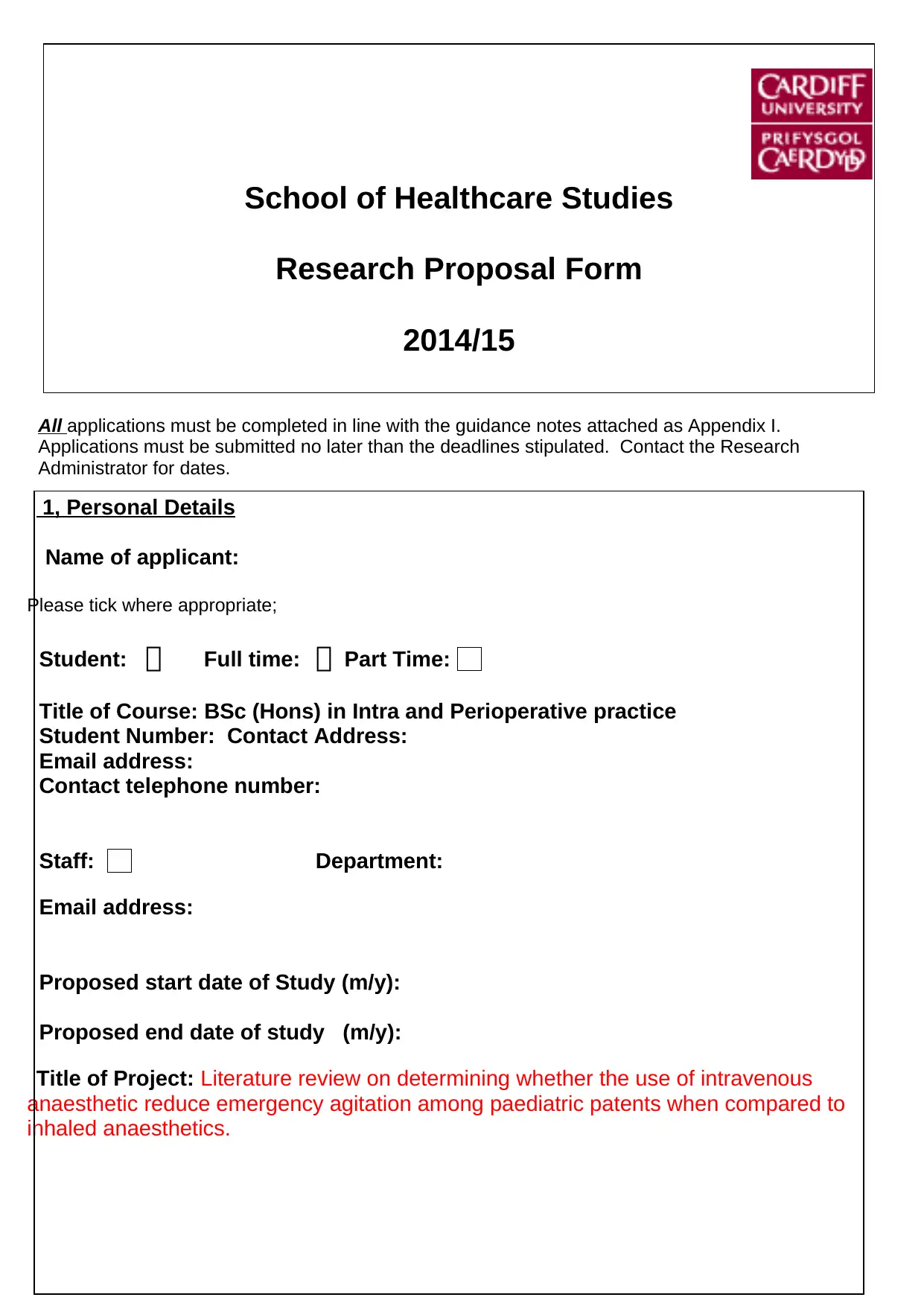
All applications must be completed in line with the guidance notes attached as Appendix I.
Applications must be submitted no later than the deadlines stipulated. Contact the Research
Administrator for dates.
School of Healthcare Studies
Research Proposal Form
2014/15
1, Personal Details
Name of applicant:
Please tick where appropriate;
Student: Full time: Part Time:
Title of Course: BSc (Hons) in Intra and Perioperative practice
Student Number: Contact Address:
Email address:
Contact telephone number:
Staff: Department:
Email address:
Proposed start date of Study (m/y):
Proposed end date of study (m/y):
Title of Project: Literature review on determining whether the use of intravenous
anaesthetic reduce emergency agitation among paediatric patents when compared to
inhaled anaesthetics.
Applications must be submitted no later than the deadlines stipulated. Contact the Research
Administrator for dates.
School of Healthcare Studies
Research Proposal Form
2014/15
1, Personal Details
Name of applicant:
Please tick where appropriate;
Student: Full time: Part Time:
Title of Course: BSc (Hons) in Intra and Perioperative practice
Student Number: Contact Address:
Email address:
Contact telephone number:
Staff: Department:
Email address:
Proposed start date of Study (m/y):
Proposed end date of study (m/y):
Title of Project: Literature review on determining whether the use of intravenous
anaesthetic reduce emergency agitation among paediatric patents when compared to
inhaled anaesthetics.
Paraphrase This Document
Need a fresh take? Get an instant paraphrase of this document with our AI Paraphraser

Late applications will not be considered.
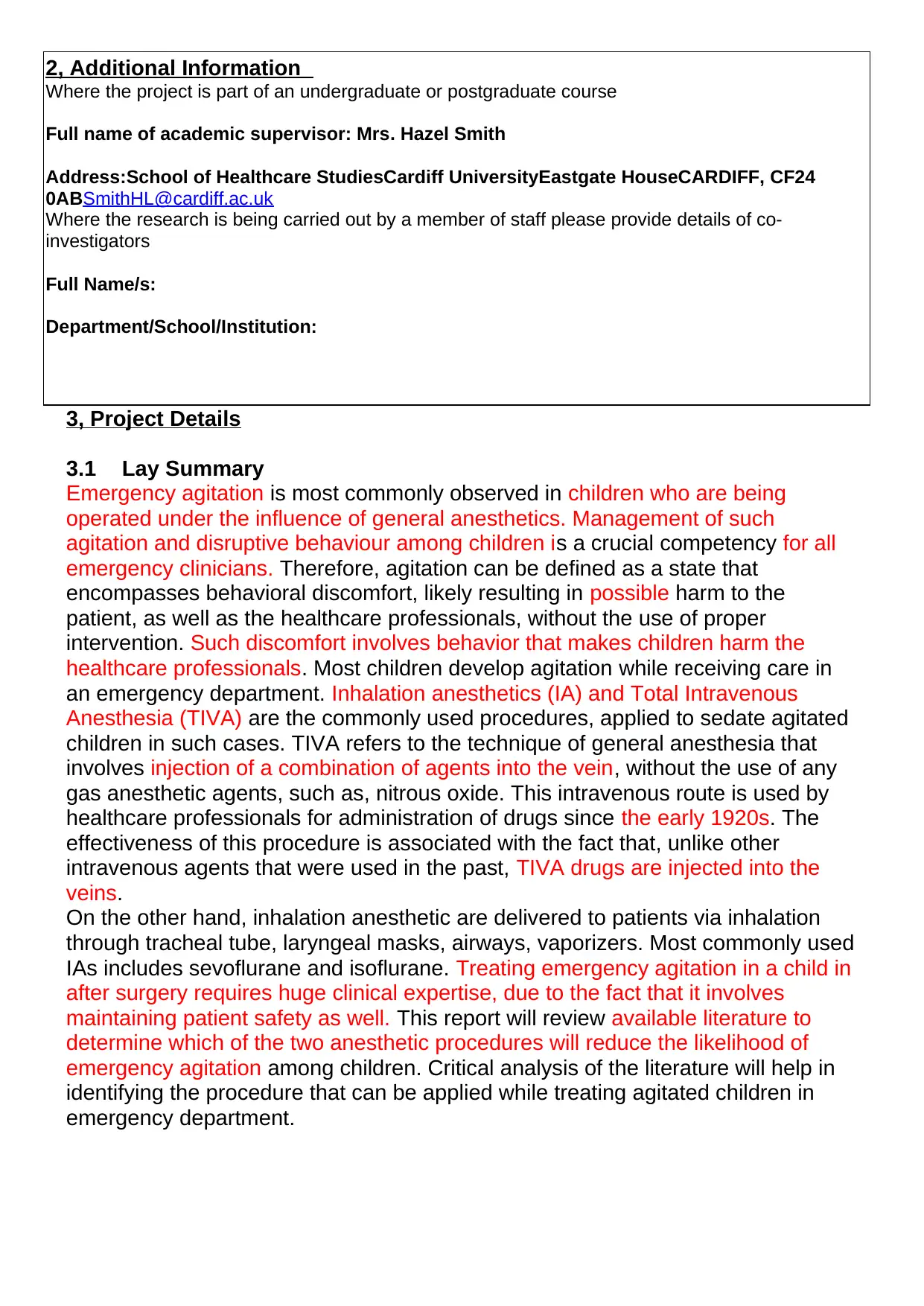
3, Project Details
3.1 Lay Summary
Emergency agitation is most commonly observed in children who are being
operated under the influence of general anesthetics. Management of such
agitation and disruptive behaviour among children is a crucial competency for all
emergency clinicians. Therefore, agitation can be defined as a state that
encompasses behavioral discomfort, likely resulting in possible harm to the
patient, as well as the healthcare professionals, without the use of proper
intervention. Such discomfort involves behavior that makes children harm the
healthcare professionals. Most children develop agitation while receiving care in
an emergency department. Inhalation anesthetics (IA) and Total Intravenous
Anesthesia (TIVA) are the commonly used procedures, applied to sedate agitated
children in such cases. TIVA refers to the technique of general anesthesia that
involves injection of a combination of agents into the vein, without the use of any
gas anesthetic agents, such as, nitrous oxide. This intravenous route is used by
healthcare professionals for administration of drugs since the early 1920s. The
effectiveness of this procedure is associated with the fact that, unlike other
intravenous agents that were used in the past, TIVA drugs are injected into the
veins.
On the other hand, inhalation anesthetic are delivered to patients via inhalation
through tracheal tube, laryngeal masks, airways, vaporizers. Most commonly used
IAs includes sevoflurane and isoflurane. Treating emergency agitation in a child in
after surgery requires huge clinical expertise, due to the fact that it involves
maintaining patient safety as well. This report will review available literature to
determine which of the two anesthetic procedures will reduce the likelihood of
emergency agitation among children. Critical analysis of the literature will help in
identifying the procedure that can be applied while treating agitated children in
emergency department.
2, Additional Information
Where the project is part of an undergraduate or postgraduate course
Full name of academic supervisor: Mrs. Hazel Smith
Address:School of Healthcare StudiesCardiff UniversityEastgate HouseCARDIFF, CF24
0ABSmithHL@cardiff.ac.uk
Where the research is being carried out by a member of staff please provide details of co-
investigators
Full Name/s:
Department/School/Institution:
3.1 Lay Summary
Emergency agitation is most commonly observed in children who are being
operated under the influence of general anesthetics. Management of such
agitation and disruptive behaviour among children is a crucial competency for all
emergency clinicians. Therefore, agitation can be defined as a state that
encompasses behavioral discomfort, likely resulting in possible harm to the
patient, as well as the healthcare professionals, without the use of proper
intervention. Such discomfort involves behavior that makes children harm the
healthcare professionals. Most children develop agitation while receiving care in
an emergency department. Inhalation anesthetics (IA) and Total Intravenous
Anesthesia (TIVA) are the commonly used procedures, applied to sedate agitated
children in such cases. TIVA refers to the technique of general anesthesia that
involves injection of a combination of agents into the vein, without the use of any
gas anesthetic agents, such as, nitrous oxide. This intravenous route is used by
healthcare professionals for administration of drugs since the early 1920s. The
effectiveness of this procedure is associated with the fact that, unlike other
intravenous agents that were used in the past, TIVA drugs are injected into the
veins.
On the other hand, inhalation anesthetic are delivered to patients via inhalation
through tracheal tube, laryngeal masks, airways, vaporizers. Most commonly used
IAs includes sevoflurane and isoflurane. Treating emergency agitation in a child in
after surgery requires huge clinical expertise, due to the fact that it involves
maintaining patient safety as well. This report will review available literature to
determine which of the two anesthetic procedures will reduce the likelihood of
emergency agitation among children. Critical analysis of the literature will help in
identifying the procedure that can be applied while treating agitated children in
emergency department.
2, Additional Information
Where the project is part of an undergraduate or postgraduate course
Full name of academic supervisor: Mrs. Hazel Smith
Address:School of Healthcare StudiesCardiff UniversityEastgate HouseCARDIFF, CF24
0ABSmithHL@cardiff.ac.uk
Where the research is being carried out by a member of staff please provide details of co-
investigators
Full Name/s:
Department/School/Institution:
⊘ This is a preview!⊘
Do you want full access?
Subscribe today to unlock all pages.

Trusted by 1+ million students worldwide
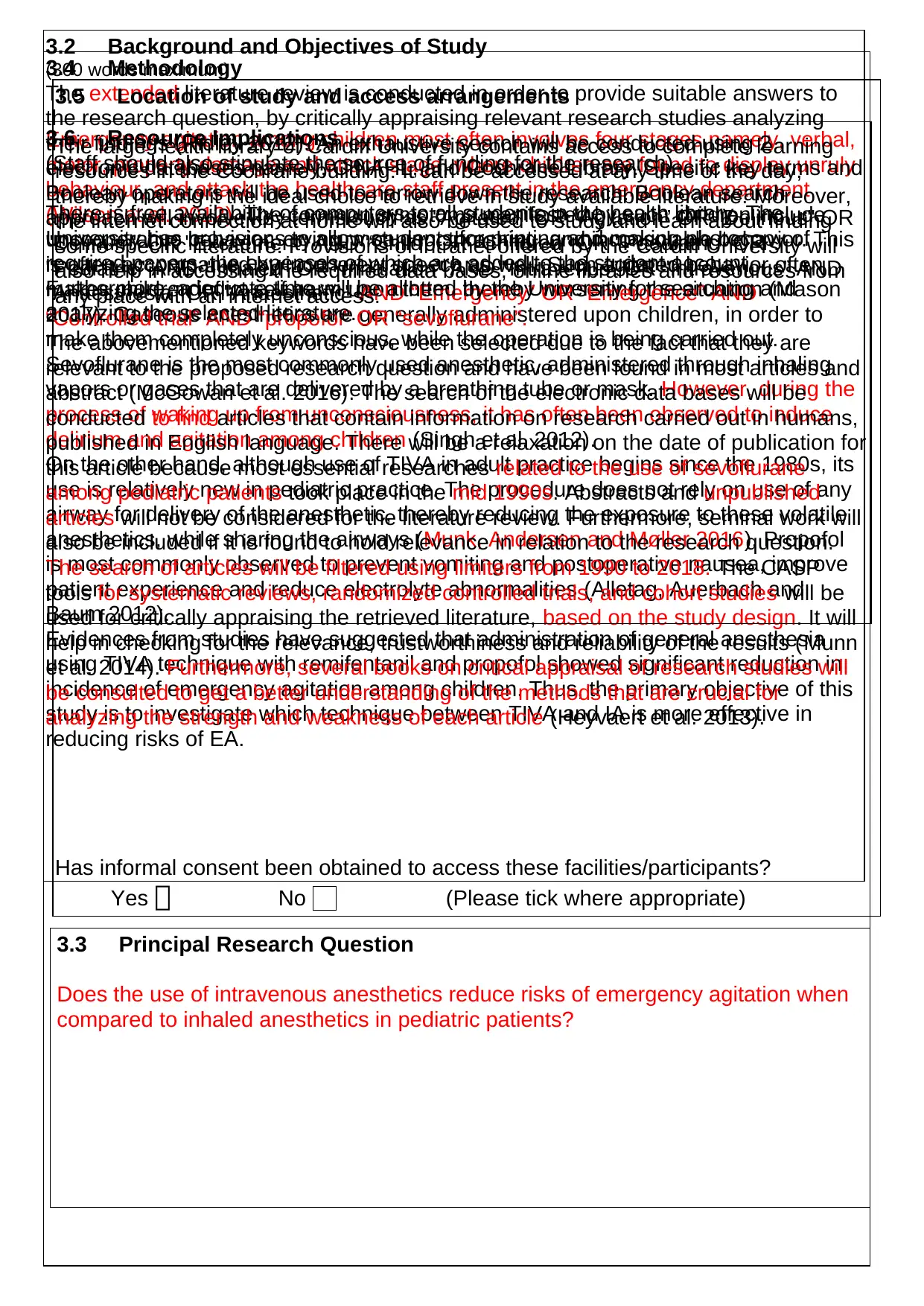
3.2 Background and Objectives of Study
(300 words maximum)
Emergency agitation among children most often involves four stages namely, verbal,
motor, property damage and attack stage, where children are found to display unruly
behaviour, and attack the healthcare staff present in the emergency department
(Wilson et al. 2012). The common symptoms manifested by such children include
uncooperative behavior, crying, moaning, thrashing, and inconsolable behavior. This
is often accompanied by incoherent speech as well. Such agitated behavior often
makes children inflict self harm upon them, thereby worsening the situation (Mason
2017). Gaseous anesthetics are generally administered upon children, in order to
make them completely unconscious, while the operation is being carried out.
Sevoflurane is the most commonly used anesthetic, administered through inhaling
vapors or gases that are delivered by a breathing tube or mask. However, during the
process of waking up from unconsciousness, it has often been observed to induce
delirium and agitation among children (Singh et al. 2012).
On the other hand, although use of TIVA in adult practice begins since the 1980s, its
use is relatively new in pediatric practice. The procedure does not rely on use of any
airway for delivery of the anesthetic, thereby reducing the exposure to these volatile
anesthetics, while sharing the airways (Munk, Andersen and Møller 2016). Propofol
is most commonly observed to prevent vomiting and postoperative nausea, improve
patient experience and reduce electrolyte abnormalities (Alletag, Auerbach and
Baum 2012).
Evidences from studies have suggested that administration of general anesthesia
using TIVA technique with remifentanil and propofol showed significant reduction in
incidence of emergency agitation among children. Thus, the primary objective of this
study is to investigate which technique between TIVA and IA is more effective in
reducing risks of EA.
3.3 Principal Research Question
Does the use of intravenous anesthetics reduce risks of emergency agitation when
compared to inhaled anesthetics in pediatric patients?
3.4 Methodology
The extended literature review is conducted in order to provide suitable answers to
the research question, by critically appraising relevant research studies analyzing
their findings (Ridley 2012). An exhaustive search will be conducted using 2
electronic databases namely, CINAHL, and Cochrane Library. Specific key terms and
Boolean operators will be used to narrow down the research. Boolean search
approach will involve key terms such as "Agitated" OR “Agitation” OR "Delirious" OR
"Delirium" OR "Excitement" AND “Child” OR "Children" OR "Paediatric" OR
"Pediatric" AND "Inhaled" OR "Inhalation" AND "Intravenus” OR "Intravenous” AND
“Anaesthesia” OR "Anaesthetic" AND “Emergency” OR “Emergence” AND
“Controlled trial” AND “propofol” OR “sevoflurane”.
The abovementioned keywords have been selected due to the fact that they are
relevant to the proposed research question and have been found in most articles and
abstract (McGowan et al. 2016). The search of the electronic data bases will be
conducted to find articles that contain information on research carried out in humans,
published in English language. There will be a relaxation on the date of publication for
this article because most essential researches related to the use of sevoflurane
among pediatric patients took place in the mid 1990s. Abstracts and unpublished
articles will not be considered for the literature review. Furthermore, seminal work will
also be included if it is found to hold relevance in relation to the research question.
The search of articles will be filtered using limiters from 1990 to 2018. The CASP
tools for systematic reviews, randomized controlled trials, and cohort studies will be
used for critically appraising the retrieved literature, based on the study design. It will
help in checking for the relevance, trustworthiness and reliability of the results (Munn
et al. 2014). Furthermore, several books on critical appraisal of research studies will
be consulted to get a better understanding of the methods that are crucial for
analyzing the strength and weakness of each article (Heyvaert et al. 2013).
3.5 Location of study and access arrangements
The large health library of Cardiff University contains access to complete learning
resources in the Cochrane building. It can be accessed at any time of the day,
thereby making it the ideal choice to retrieve in study available literature. Moreover,
the internet connection at home will also be used to study and learn about finding
some specific literature. Provisions of intranet offered by the Cardiff University will
also help in accessing the required data bases, online libraries and resources from
any place with an internet access.
Has informal consent been obtained to access these facilities/participants?
Yes No (Please tick where appropriate)
3.6 Resource Implications
(Staff should also stipulate the source of funding for the research)
There is free availability of computers to all students in the health library. The
University has provisions to allow students for printing and making photocopy of
required papers, the expenses of which are added to the student account.
Furthermore, adequate time will be allotted by the University for searching and
analyzing the selected literature.
(300 words maximum)
Emergency agitation among children most often involves four stages namely, verbal,
motor, property damage and attack stage, where children are found to display unruly
behaviour, and attack the healthcare staff present in the emergency department
(Wilson et al. 2012). The common symptoms manifested by such children include
uncooperative behavior, crying, moaning, thrashing, and inconsolable behavior. This
is often accompanied by incoherent speech as well. Such agitated behavior often
makes children inflict self harm upon them, thereby worsening the situation (Mason
2017). Gaseous anesthetics are generally administered upon children, in order to
make them completely unconscious, while the operation is being carried out.
Sevoflurane is the most commonly used anesthetic, administered through inhaling
vapors or gases that are delivered by a breathing tube or mask. However, during the
process of waking up from unconsciousness, it has often been observed to induce
delirium and agitation among children (Singh et al. 2012).
On the other hand, although use of TIVA in adult practice begins since the 1980s, its
use is relatively new in pediatric practice. The procedure does not rely on use of any
airway for delivery of the anesthetic, thereby reducing the exposure to these volatile
anesthetics, while sharing the airways (Munk, Andersen and Møller 2016). Propofol
is most commonly observed to prevent vomiting and postoperative nausea, improve
patient experience and reduce electrolyte abnormalities (Alletag, Auerbach and
Baum 2012).
Evidences from studies have suggested that administration of general anesthesia
using TIVA technique with remifentanil and propofol showed significant reduction in
incidence of emergency agitation among children. Thus, the primary objective of this
study is to investigate which technique between TIVA and IA is more effective in
reducing risks of EA.
3.3 Principal Research Question
Does the use of intravenous anesthetics reduce risks of emergency agitation when
compared to inhaled anesthetics in pediatric patients?
3.4 Methodology
The extended literature review is conducted in order to provide suitable answers to
the research question, by critically appraising relevant research studies analyzing
their findings (Ridley 2012). An exhaustive search will be conducted using 2
electronic databases namely, CINAHL, and Cochrane Library. Specific key terms and
Boolean operators will be used to narrow down the research. Boolean search
approach will involve key terms such as "Agitated" OR “Agitation” OR "Delirious" OR
"Delirium" OR "Excitement" AND “Child” OR "Children" OR "Paediatric" OR
"Pediatric" AND "Inhaled" OR "Inhalation" AND "Intravenus” OR "Intravenous” AND
“Anaesthesia” OR "Anaesthetic" AND “Emergency” OR “Emergence” AND
“Controlled trial” AND “propofol” OR “sevoflurane”.
The abovementioned keywords have been selected due to the fact that they are
relevant to the proposed research question and have been found in most articles and
abstract (McGowan et al. 2016). The search of the electronic data bases will be
conducted to find articles that contain information on research carried out in humans,
published in English language. There will be a relaxation on the date of publication for
this article because most essential researches related to the use of sevoflurane
among pediatric patients took place in the mid 1990s. Abstracts and unpublished
articles will not be considered for the literature review. Furthermore, seminal work will
also be included if it is found to hold relevance in relation to the research question.
The search of articles will be filtered using limiters from 1990 to 2018. The CASP
tools for systematic reviews, randomized controlled trials, and cohort studies will be
used for critically appraising the retrieved literature, based on the study design. It will
help in checking for the relevance, trustworthiness and reliability of the results (Munn
et al. 2014). Furthermore, several books on critical appraisal of research studies will
be consulted to get a better understanding of the methods that are crucial for
analyzing the strength and weakness of each article (Heyvaert et al. 2013).
3.5 Location of study and access arrangements
The large health library of Cardiff University contains access to complete learning
resources in the Cochrane building. It can be accessed at any time of the day,
thereby making it the ideal choice to retrieve in study available literature. Moreover,
the internet connection at home will also be used to study and learn about finding
some specific literature. Provisions of intranet offered by the Cardiff University will
also help in accessing the required data bases, online libraries and resources from
any place with an internet access.
Has informal consent been obtained to access these facilities/participants?
Yes No (Please tick where appropriate)
3.6 Resource Implications
(Staff should also stipulate the source of funding for the research)
There is free availability of computers to all students in the health library. The
University has provisions to allow students for printing and making photocopy of
required papers, the expenses of which are added to the student account.
Furthermore, adequate time will be allotted by the University for searching and
analyzing the selected literature.
Paraphrase This Document
Need a fresh take? Get an instant paraphrase of this document with our AI Paraphraser
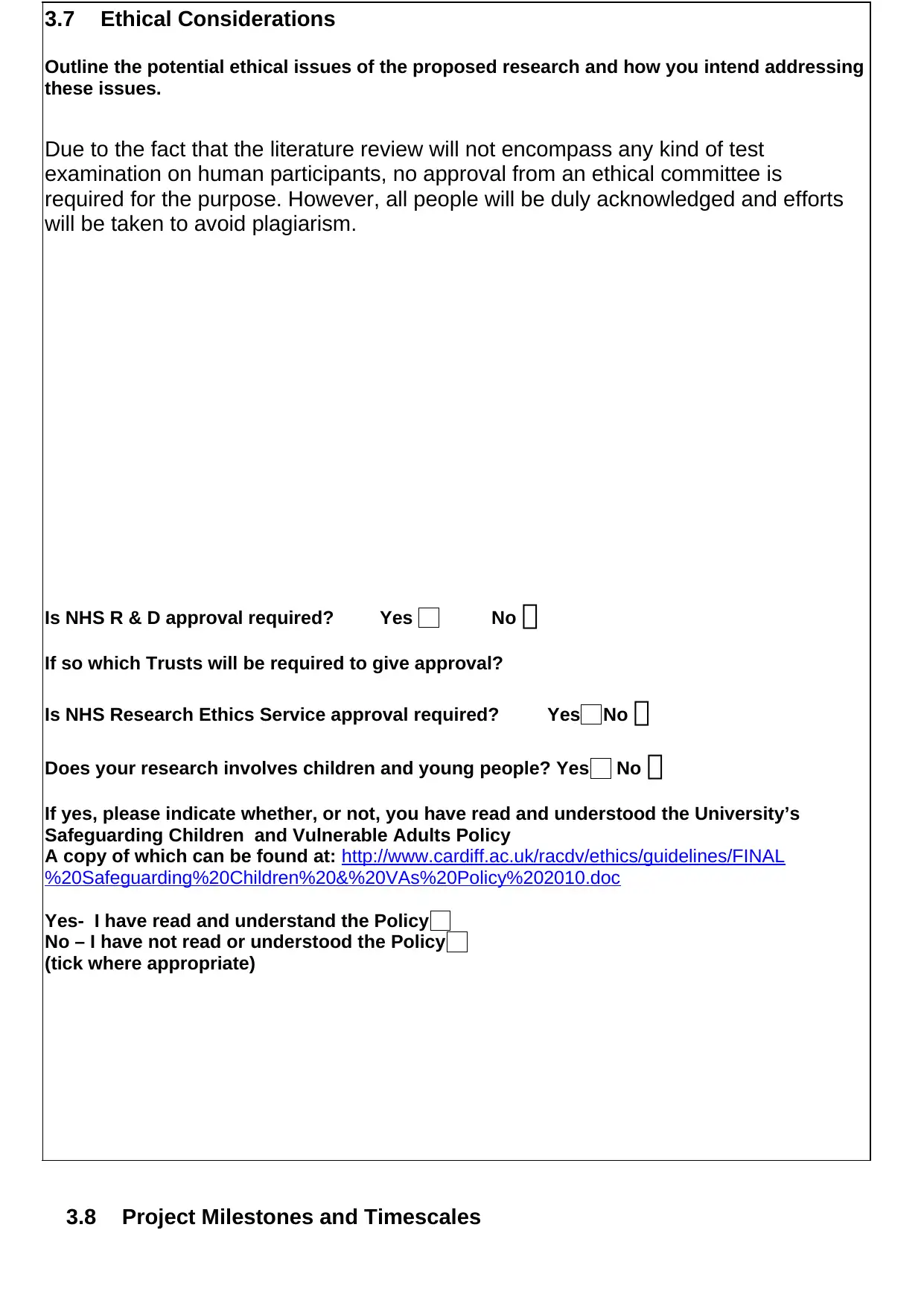
3.8 Project Milestones and Timescales
3.7 Ethical Considerations
Outline the potential ethical issues of the proposed research and how you intend addressing
these issues.
Due to the fact that the literature review will not encompass any kind of test
examination on human participants, no approval from an ethical committee is
required for the purpose. However, all people will be duly acknowledged and efforts
will be taken to avoid plagiarism.
Is NHS R & D approval required? Yes No
If so which Trusts will be required to give approval?
Is NHS Research Ethics Service approval required? Yes No
Does your research involves children and young people? Yes No
If yes, please indicate whether, or not, you have read and understood the University’s
Safeguarding Children and Vulnerable Adults Policy
A copy of which can be found at: http://www.cardiff.ac.uk/racdv/ethics/guidelines/FINAL
%20Safeguarding%20Children%20&%20VAs%20Policy%202010.doc
Yes- I have read and understand the Policy
No – I have not read or understood the Policy
(tick where appropriate)
3.7 Ethical Considerations
Outline the potential ethical issues of the proposed research and how you intend addressing
these issues.
Due to the fact that the literature review will not encompass any kind of test
examination on human participants, no approval from an ethical committee is
required for the purpose. However, all people will be duly acknowledged and efforts
will be taken to avoid plagiarism.
Is NHS R & D approval required? Yes No
If so which Trusts will be required to give approval?
Is NHS Research Ethics Service approval required? Yes No
Does your research involves children and young people? Yes No
If yes, please indicate whether, or not, you have read and understood the University’s
Safeguarding Children and Vulnerable Adults Policy
A copy of which can be found at: http://www.cardiff.ac.uk/racdv/ethics/guidelines/FINAL
%20Safeguarding%20Children%20&%20VAs%20Policy%202010.doc
Yes- I have read and understand the Policy
No – I have not read or understood the Policy
(tick where appropriate)
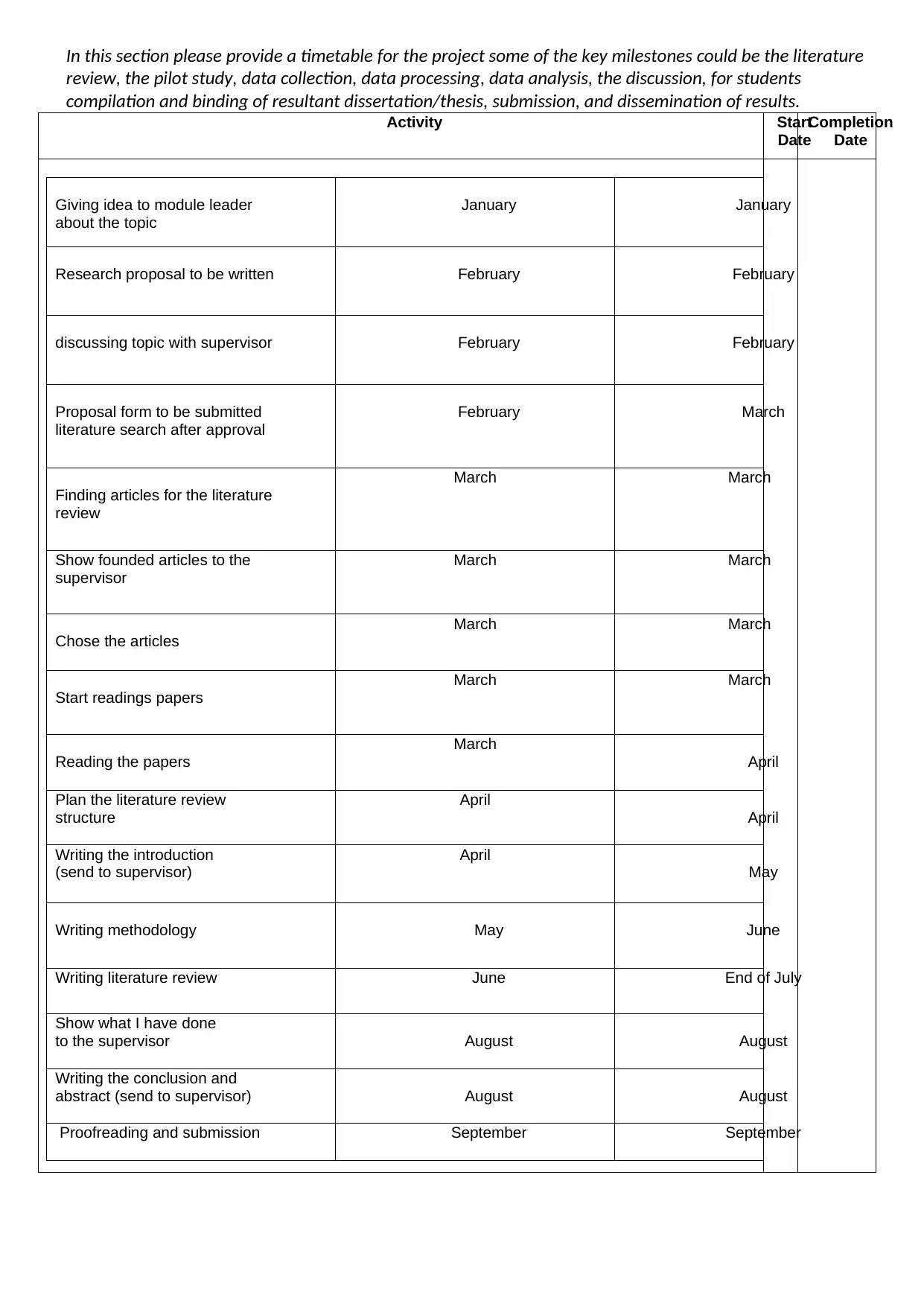
In this section please provide a timetable for the project some of the key milestones could be the literature
review, the pilot study, data collection, data processing, data analysis, the discussion, for students
compilation and binding of resultant dissertation/thesis, submission, and dissemination of results.
Activity Start
Date
Completion
Date
Giving idea to module leader
about the topic
January January
Research proposal to be written February February
discussing topic with supervisor February February
Proposal form to be submitted
literature search after approval
February March
Finding articles for the literature
review
March March
Show founded articles to the
supervisor
March March
Chose the articles
March March
Start readings papers
March March
Reading the papers
March
April
Plan the literature review
structure
April
April
Writing the introduction
(send to supervisor)
April
May
Writing methodology May June
Writing literature review June End of July
Show what I have done
to the supervisor August August
Writing the conclusion and
abstract (send to supervisor) August August
Proofreading and submission September September
review, the pilot study, data collection, data processing, data analysis, the discussion, for students
compilation and binding of resultant dissertation/thesis, submission, and dissemination of results.
Activity Start
Date
Completion
Date
Giving idea to module leader
about the topic
January January
Research proposal to be written February February
discussing topic with supervisor February February
Proposal form to be submitted
literature search after approval
February March
Finding articles for the literature
review
March March
Show founded articles to the
supervisor
March March
Chose the articles
March March
Start readings papers
March March
Reading the papers
March
April
Plan the literature review
structure
April
April
Writing the introduction
(send to supervisor)
April
May
Writing methodology May June
Writing literature review June End of July
Show what I have done
to the supervisor August August
Writing the conclusion and
abstract (send to supervisor) August August
Proofreading and submission September September
⊘ This is a preview!⊘
Do you want full access?
Subscribe today to unlock all pages.

Trusted by 1+ million students worldwide
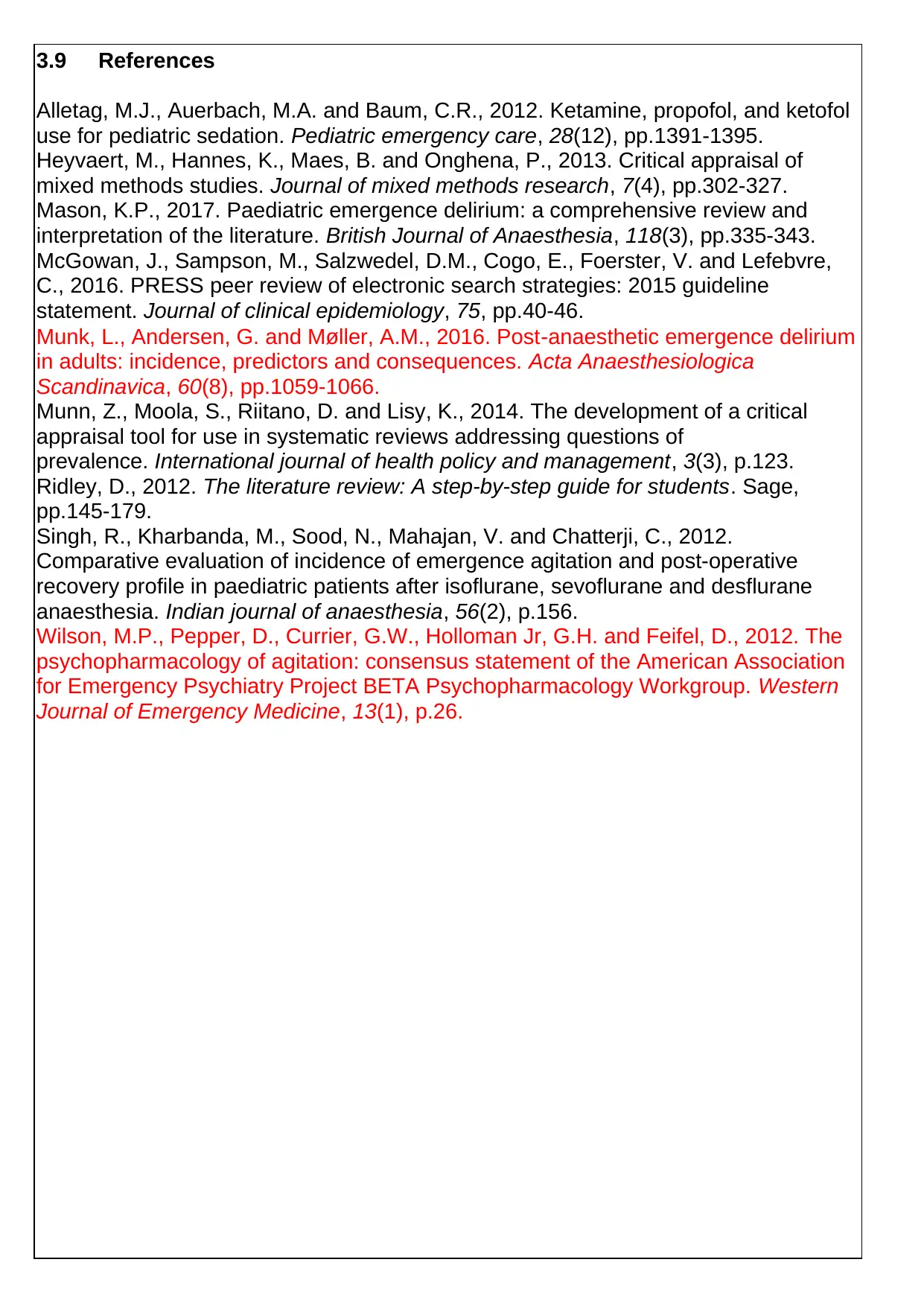
3.9 References
Alletag, M.J., Auerbach, M.A. and Baum, C.R., 2012. Ketamine, propofol, and ketofol
use for pediatric sedation. Pediatric emergency care, 28(12), pp.1391-1395.
Heyvaert, M., Hannes, K., Maes, B. and Onghena, P., 2013. Critical appraisal of
mixed methods studies. Journal of mixed methods research, 7(4), pp.302-327.
Mason, K.P., 2017. Paediatric emergence delirium: a comprehensive review and
interpretation of the literature. British Journal of Anaesthesia, 118(3), pp.335-343.
McGowan, J., Sampson, M., Salzwedel, D.M., Cogo, E., Foerster, V. and Lefebvre,
C., 2016. PRESS peer review of electronic search strategies: 2015 guideline
statement. Journal of clinical epidemiology, 75, pp.40-46.
Munk, L., Andersen, G. and Møller, A.M., 2016. Post‐anaesthetic emergence delirium
in adults: incidence, predictors and consequences. Acta Anaesthesiologica
Scandinavica, 60(8), pp.1059-1066.
Munn, Z., Moola, S., Riitano, D. and Lisy, K., 2014. The development of a critical
appraisal tool for use in systematic reviews addressing questions of
prevalence. International journal of health policy and management, 3(3), p.123.
Ridley, D., 2012. The literature review: A step-by-step guide for students. Sage,
pp.145-179.
Singh, R., Kharbanda, M., Sood, N., Mahajan, V. and Chatterji, C., 2012.
Comparative evaluation of incidence of emergence agitation and post-operative
recovery profile in paediatric patients after isoflurane, sevoflurane and desflurane
anaesthesia. Indian journal of anaesthesia, 56(2), p.156.
Wilson, M.P., Pepper, D., Currier, G.W., Holloman Jr, G.H. and Feifel, D., 2012. The
psychopharmacology of agitation: consensus statement of the American Association
for Emergency Psychiatry Project BETA Psychopharmacology Workgroup. Western
Journal of Emergency Medicine, 13(1), p.26.
Alletag, M.J., Auerbach, M.A. and Baum, C.R., 2012. Ketamine, propofol, and ketofol
use for pediatric sedation. Pediatric emergency care, 28(12), pp.1391-1395.
Heyvaert, M., Hannes, K., Maes, B. and Onghena, P., 2013. Critical appraisal of
mixed methods studies. Journal of mixed methods research, 7(4), pp.302-327.
Mason, K.P., 2017. Paediatric emergence delirium: a comprehensive review and
interpretation of the literature. British Journal of Anaesthesia, 118(3), pp.335-343.
McGowan, J., Sampson, M., Salzwedel, D.M., Cogo, E., Foerster, V. and Lefebvre,
C., 2016. PRESS peer review of electronic search strategies: 2015 guideline
statement. Journal of clinical epidemiology, 75, pp.40-46.
Munk, L., Andersen, G. and Møller, A.M., 2016. Post‐anaesthetic emergence delirium
in adults: incidence, predictors and consequences. Acta Anaesthesiologica
Scandinavica, 60(8), pp.1059-1066.
Munn, Z., Moola, S., Riitano, D. and Lisy, K., 2014. The development of a critical
appraisal tool for use in systematic reviews addressing questions of
prevalence. International journal of health policy and management, 3(3), p.123.
Ridley, D., 2012. The literature review: A step-by-step guide for students. Sage,
pp.145-179.
Singh, R., Kharbanda, M., Sood, N., Mahajan, V. and Chatterji, C., 2012.
Comparative evaluation of incidence of emergence agitation and post-operative
recovery profile in paediatric patients after isoflurane, sevoflurane and desflurane
anaesthesia. Indian journal of anaesthesia, 56(2), p.156.
Wilson, M.P., Pepper, D., Currier, G.W., Holloman Jr, G.H. and Feifel, D., 2012. The
psychopharmacology of agitation: consensus statement of the American Association
for Emergency Psychiatry Project BETA Psychopharmacology Workgroup. Western
Journal of Emergency Medicine, 13(1), p.26.
Paraphrase This Document
Need a fresh take? Get an instant paraphrase of this document with our AI Paraphraser
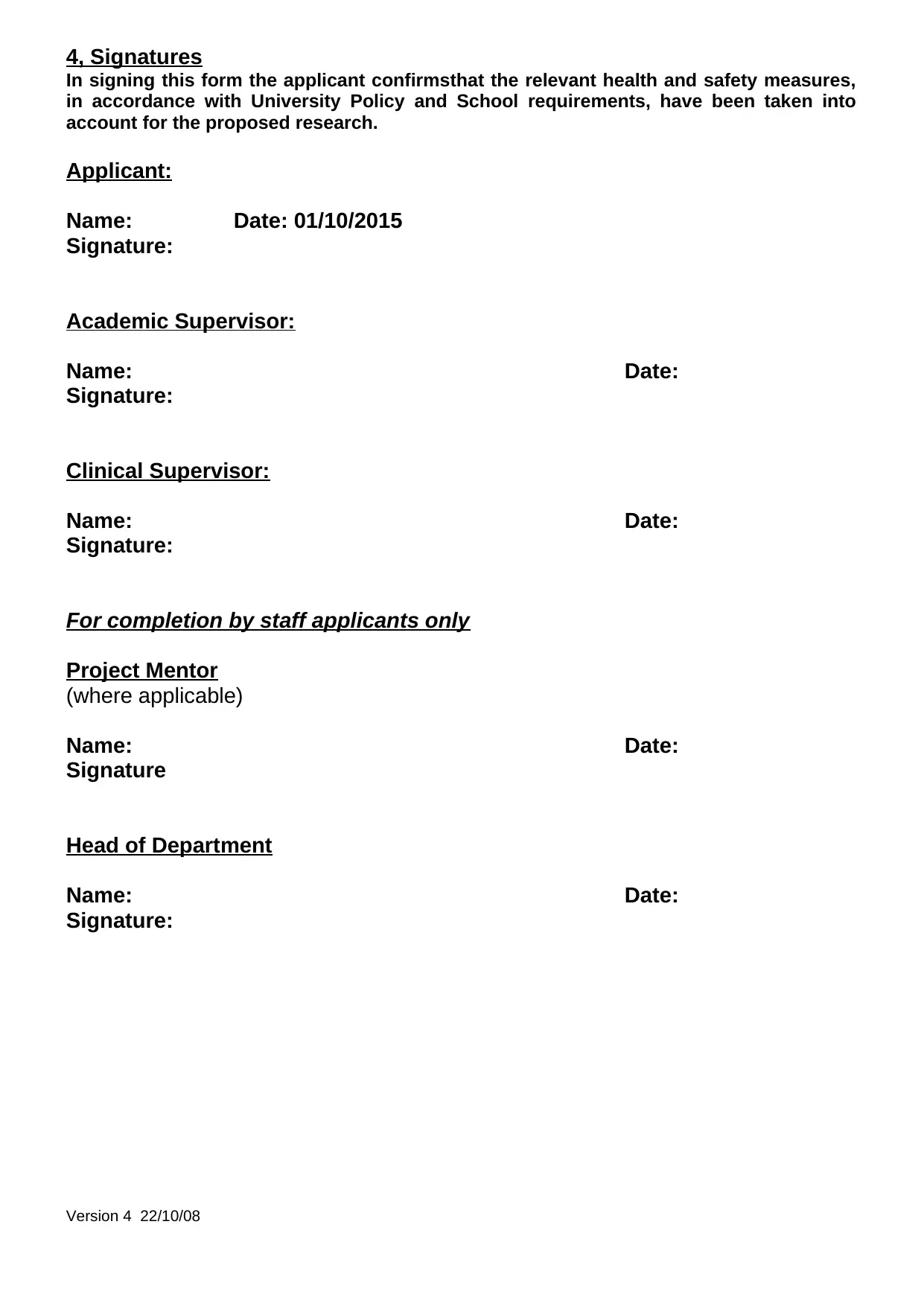
4, Signatures
In signing this form the applicant confirmsthat the relevant health and safety measures,
in accordance with University Policy and School requirements, have been taken into
account for the proposed research.
Applicant:
Name: Date: 01/10/2015
Signature:
Academic Supervisor:
Name: Date:
Signature:
Clinical Supervisor:
Name: Date:
Signature:
For completion by staff applicants only
Project Mentor
(where applicable)
Name: Date:
Signature
Head of Department
Name: Date:
Signature:
Version 4 22/10/08
In signing this form the applicant confirmsthat the relevant health and safety measures,
in accordance with University Policy and School requirements, have been taken into
account for the proposed research.
Applicant:
Name: Date: 01/10/2015
Signature:
Academic Supervisor:
Name: Date:
Signature:
Clinical Supervisor:
Name: Date:
Signature:
For completion by staff applicants only
Project Mentor
(where applicable)
Name: Date:
Signature
Head of Department
Name: Date:
Signature:
Version 4 22/10/08
1 out of 8
Your All-in-One AI-Powered Toolkit for Academic Success.
+13062052269
info@desklib.com
Available 24*7 on WhatsApp / Email
![[object Object]](/_next/static/media/star-bottom.7253800d.svg)
Unlock your academic potential
Copyright © 2020–2025 A2Z Services. All Rights Reserved. Developed and managed by ZUCOL.


